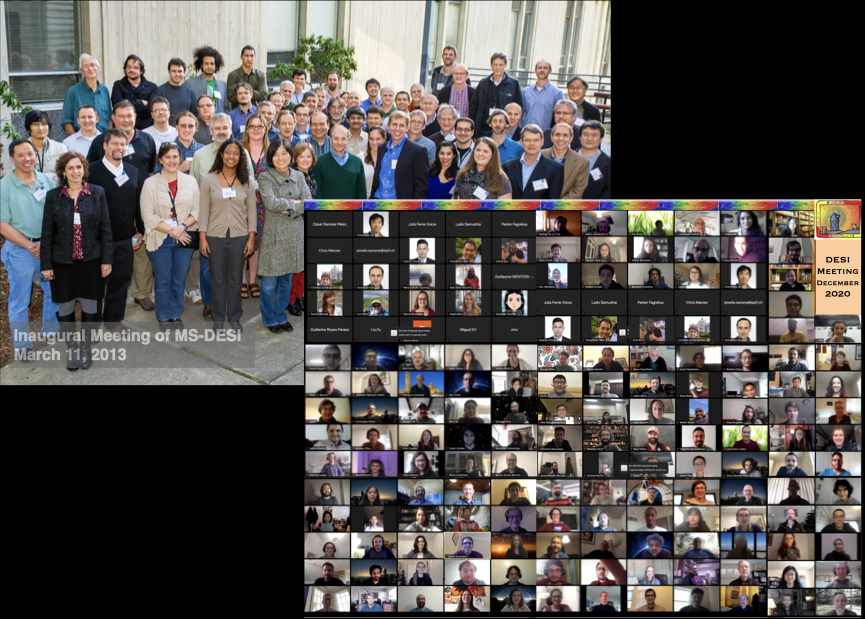Michael Levi, DESI Director
May 14, 2021
On the eve of the official start of the DESI science survey, I wanted to take a minute to reflect on how we arrived at this exciting moment. We’ve now proven that we can obtain 100,000 science-quality spectra in a single night, so we are ready! It has been quite a long and at times bumpy road to get here, but it has always been an honor to be part of this team. Of course, the ground was prepared by SDSS-BOSS, which established BAO as a precision probe of dark energy and created a desire to go beyond plug-plates. The seeds of this project germinated in 2008 out of the DOE/NASA JDEM space mission competition, when Saul Perlmutter and I were co-PI’s of the SNAP/JDEM proposal. The competing JDEM concepts led to the realization that a lot of the proposed BAO science could be performed from the ground, and this in turn led very quickly to a new concept for a ground-based spectroscopic survey. A rapid-fire set of ad hoc proposals and public presentations to DOE and NSF agency committees ensued as a core formed around this idea.
At the 2009 Particle Astrophysics Scientific Assessment Group (a subpanel of the NSF/DOE HEPAP Federal Advisory Committee), Nikhil Padmanabhan (then an LBNL Chamberlain Fellow), gave a presentation, which resulted in a recommendation to support the R&D. David Schlegel presented the BigBOSS concept to the 2010 Decadal Survey, which recommended mid-scale projects, explicitly calling out ground-based spectroscopic surveys as a compelling area of interest. In early 2011, two unsolicited proposals were submitted to DOE, for BigBOSS led by LBNL, and for DESpec a competing concept led by FNAL. This prompted the formation in mid-2011 of a dark energy community planning panel, chaired by Rocky Kolb, to advise the agency. The panel identified a wide-field spectroscopic survey as a key project that would meet the needs of the dark energy community. DOE agreed and, in the year following, approved “Mission Need” (aka CD-0) for a Mid-Scale Dark Energy Spectroscopic Instrument (MS-DESI) on Sept 18, 2012.

DOE didn’t make a down-select between BigBOSS and DESpec. Instead, they assigned the management of the new MS-DESI project to Berkeley Lab on Dec 12, 2012 and charged us to form a new collaboration. I was appointed Project Director the next week and given the task to figure it out and come back with a plan. Fortunately, we had just received a $2.1M grant from the Gordon and Betty Moore Foundation for a spectroscopic survey (followed a bit later by a similar grant from the Heising-Simons Foundation) and this provided the financial resources for us to get started building the first spectrograph and initiating the long-lead acquisition of the corrector lenses. At the same time, we began to hold collaboration meetings and created a “big tent” where all were welcome, and the DESI collaboration grew to include most of the institutions of the original proposals, plus many additional recruits.
A year later, in 2013, I presented the new plan and the newly formed science goals to the Particle Physics Project Prioritization Panel (P5), a subpanel of the NSF/DOE HEPAP Federal Advisory Committee. The P5 report, issued in mid-2014, recommended MS-DESI only in an optimistic budget scenario. Fortunately, budgets did align sufficiently for us to eke out a start in 2015 (albeit financially constrained) with CD-1 approval (site selection, and establishment of cost range) in March 2015 and with Congressional authorization in the appropriations language that year. DESI was then baselined in Sept 2015, construction started, and the rest is history as they say. Although there were plenty of remaining bumps in the road during construction, I will save that for another time.
It is a privilege for me to represent the collaboration and contribute to its continuing success, and I hope all our collaborators feel equally privileged. The DESI collaboration has come together in this common quest to understand dark energy and the mysteries of the accelerating Universe. Now the telescope and instrument are humming, twilight and science awaits.
